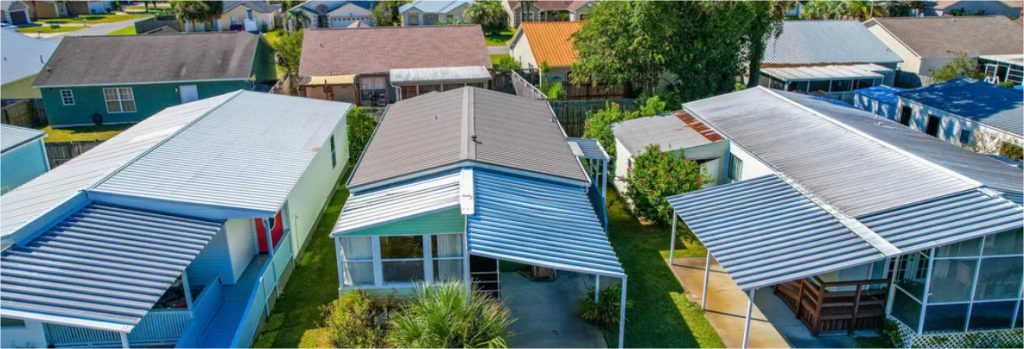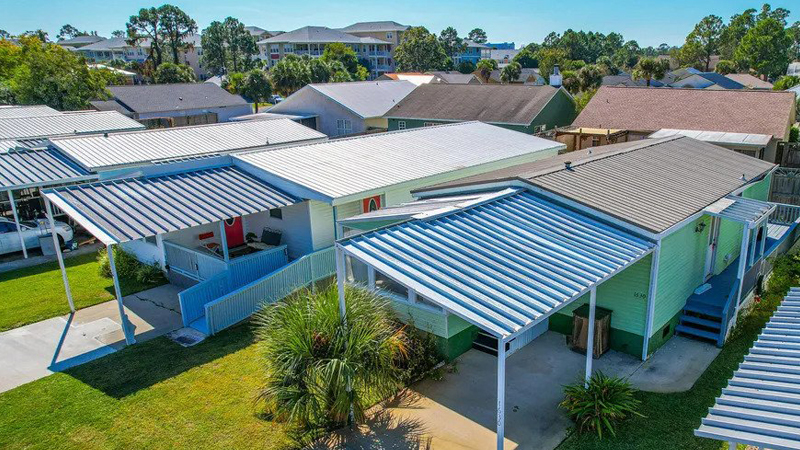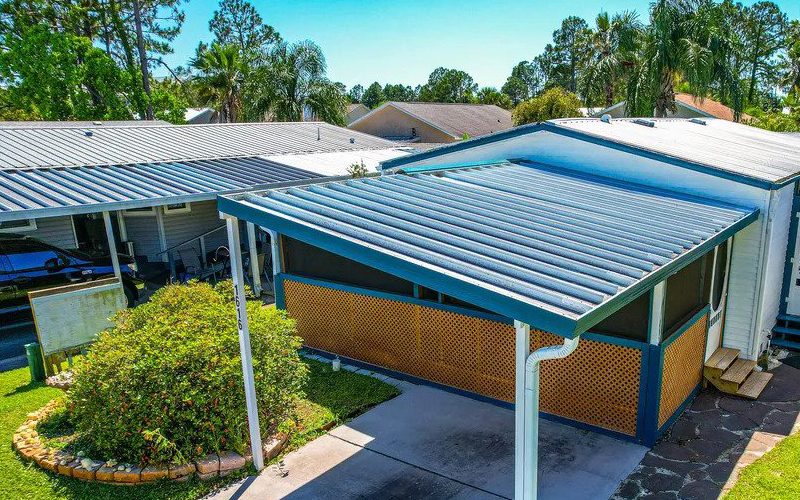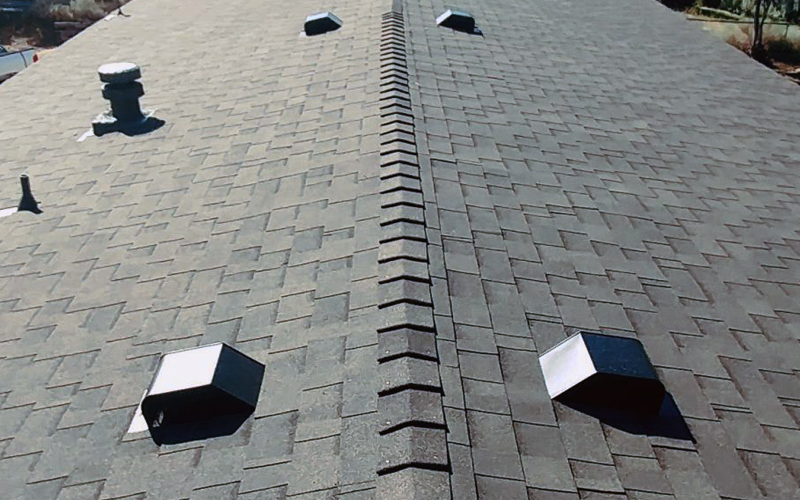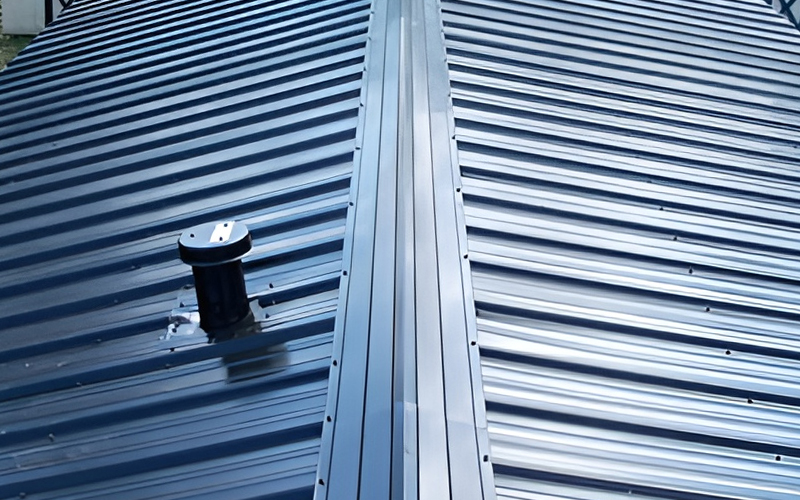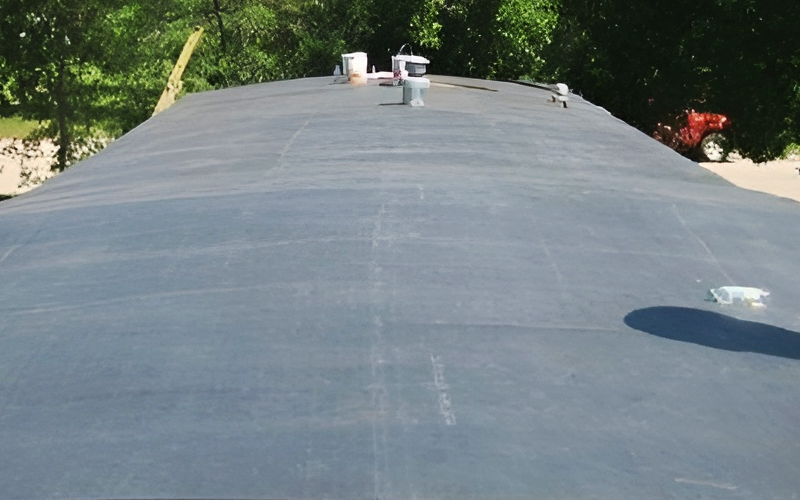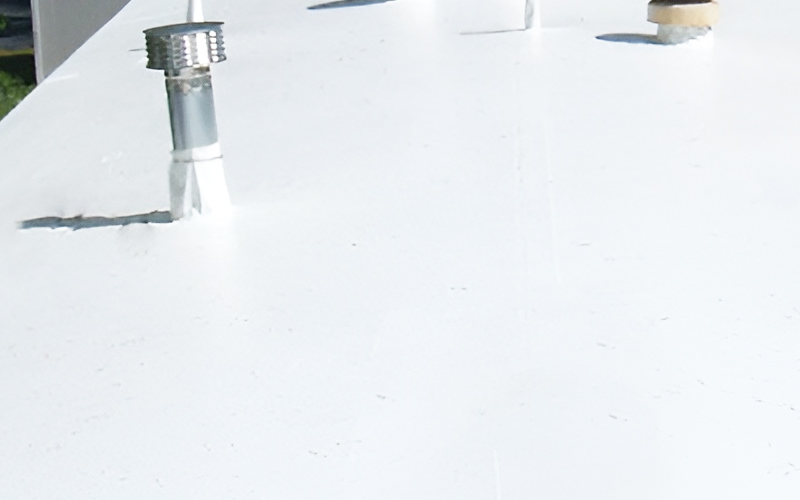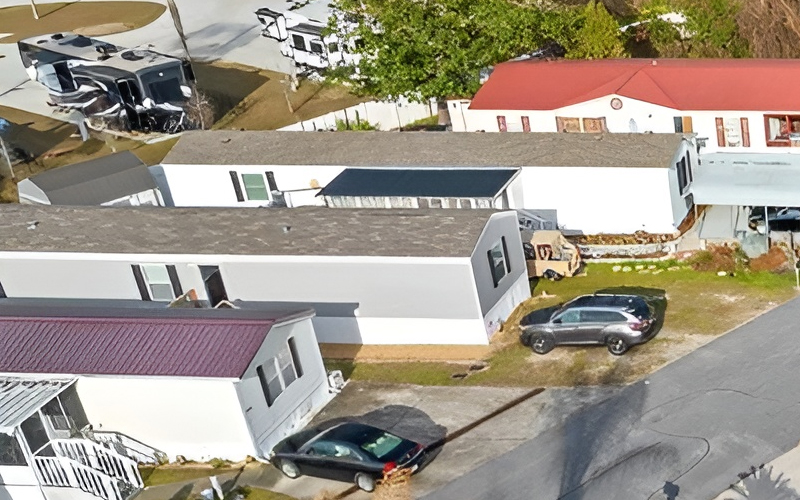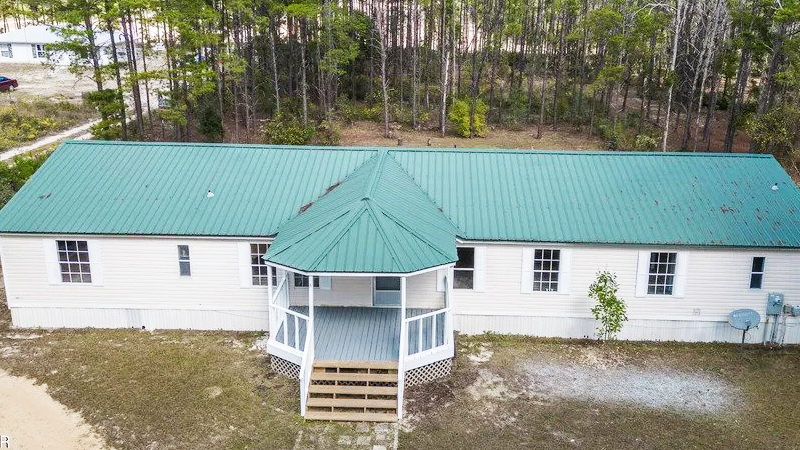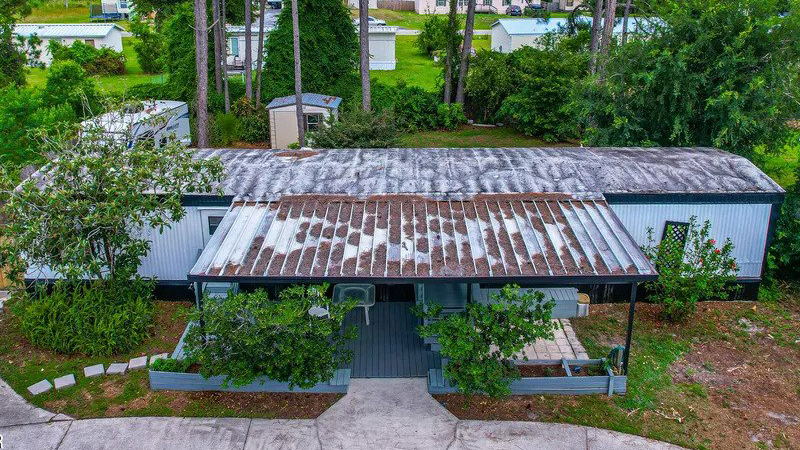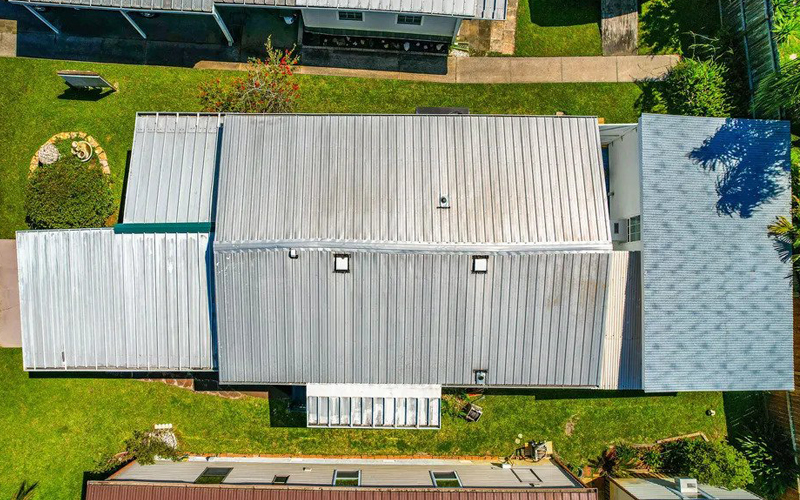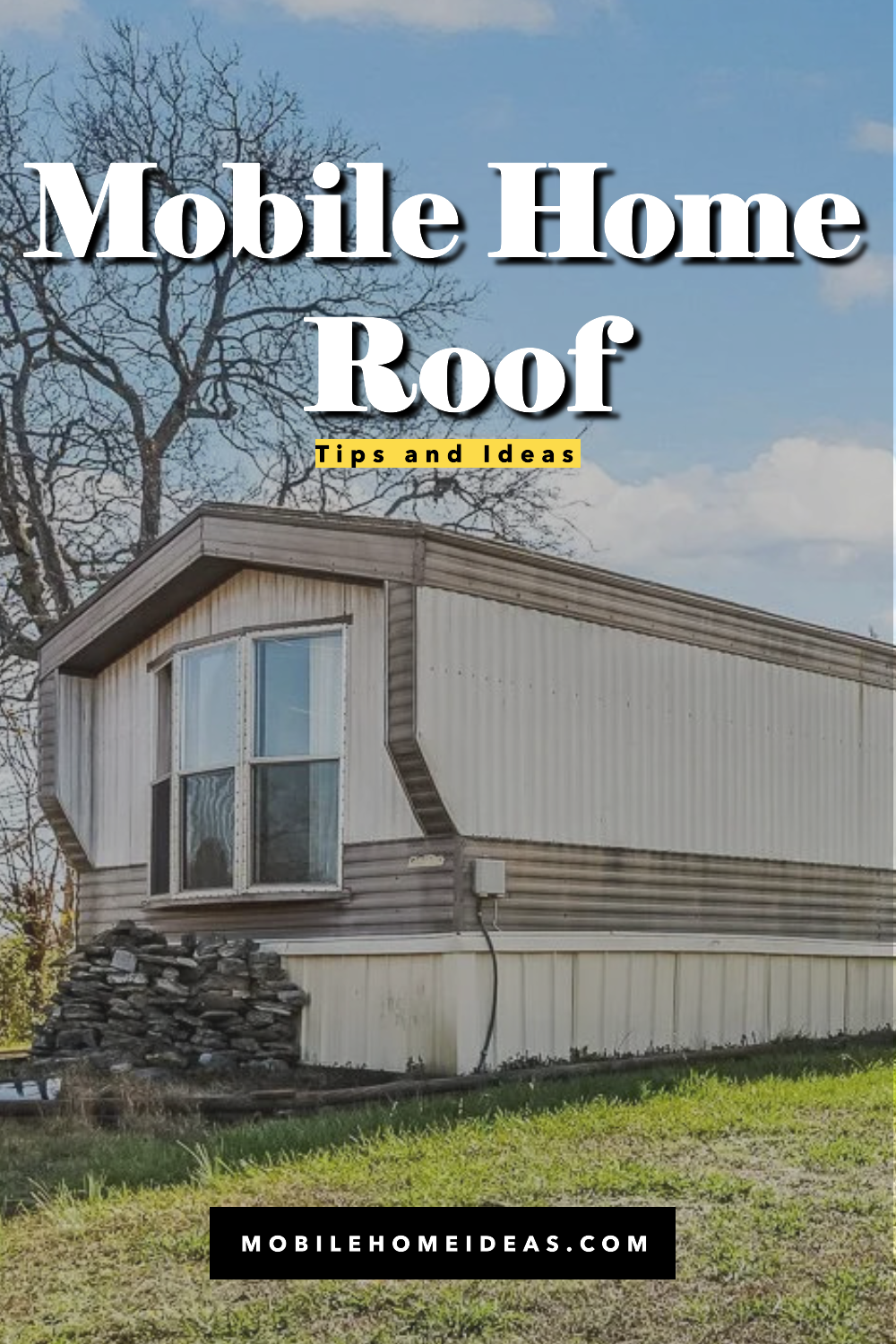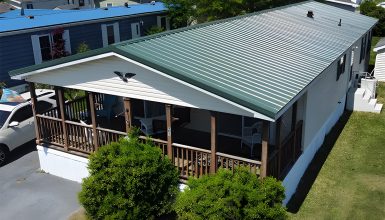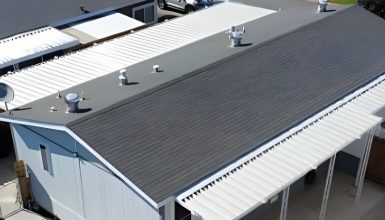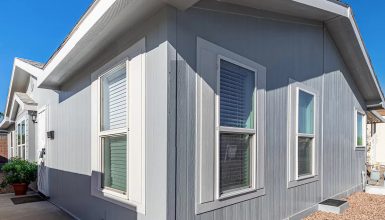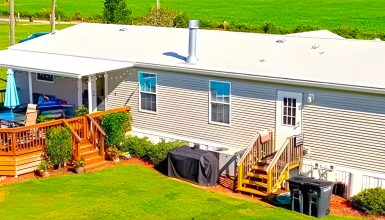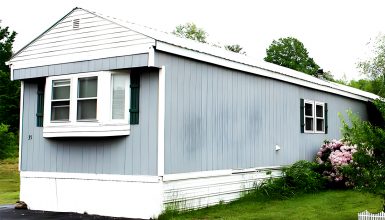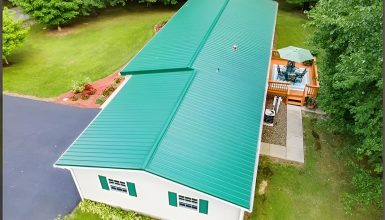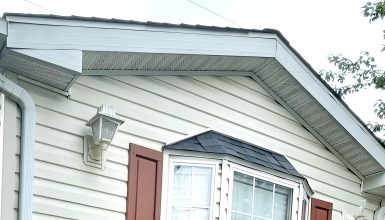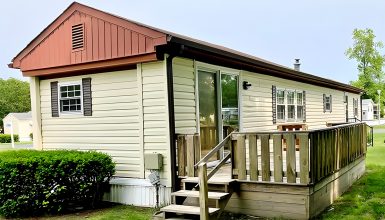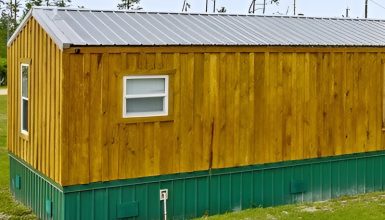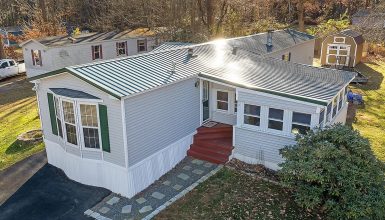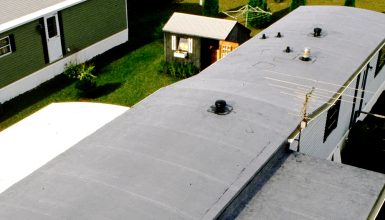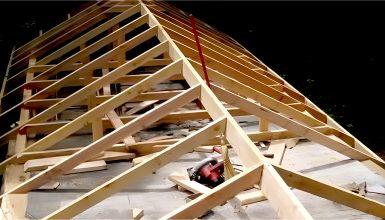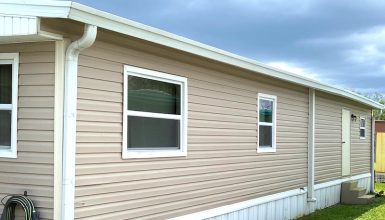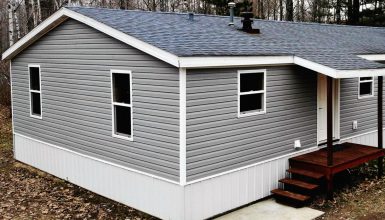Roof is critical to your mobile home’s structure, providing essential protection from the elements. Without a solid and secure roof, you risk costly damage to your home’s interior and belongings, not to mention potential safety hazards. A good roof protects your home and ensures your safety and comfort. This guide will examine the roofing options available for mobile homes. Also, provide insights on choosing the best roofing material for your needs.
Types of Mobile Home Roof Shapes
Mobile homes come in a variety of shapes and sizes and different types of roof styles. Knowing which type of roof your mobile home is essential. It can help you determine the best materials and techniques for maintenance and repairs.
- Flat Roofs
The term “flat roof” is a bit of a misnomer. They’re not entirely flat but have a slight pitch, usually about 2%. This helps water drain off instead of pooling. The charm of a flat roof lies in its simplicity and affordability. It’s typically covered with a material like rubber or PVC membrane. One thing to keep in mind? Flat roofs can be more prone to leaks, so regular maintenance is key!
- Pitched Roofs
These are the sloped ones. Pitched roofs are popular for their durability and superior water runoff. The slope varies, but it’s typically steeper than a flat roof, meaning rain and snow have a harder time sticking around. The coverings for pitched roofs can be metal, asphalt shingles, or even wood shakes. Pitched roofs often have a longer lifespan than flat roofs, but they can be more expensive to install.
- Bowstring Roofs
These are a little less common but still worth noting. Bowstring roofs have an arch-like shape, like the string and body of a drawn bow. This design allows for more interior space and can withstand heavy wind loads. However, their unique shape can make repairs a bit trickier.
- Dome Roofs
Ever seen a roof that looks like half of a sphere? That’s a dome roof! They’re not very common on mobile homes, but they offer excellent strength and wind resistance.
- Gable Roofs
These roofs are a subtype of pitched roofs, but they deserve a shout-out. Gable roofs have two sloping sides that come together at a ridge, creating a shape reminiscent of a classic children’s house drawing. They offer good water runoff and can be covered with various materials.
Common Mobile Home Roofing Materials
When it comes to mobile home roofing, there are a variety of materials to choose from. The type of material you select has significantly impacted the roof’s longevity, durability, and energy efficiency.
1. Asphalt Shingles
Asphalt shingles are one of the most common roofing materials for mobile homes. They are popular due to their affordability, ease of installation, and versatility. Asphalt shingles are made from a base mat coated with asphalt and granules to create a durable and weather-resistant material.
- Pros
There are two types of asphalt shingles: organic and fiberglass. Organic asphalt shingles are made from recycled paper and are coated with asphalt for durability. They are heavier than fiberglass shingles and have a rougher texture. Fiberglass shingles are made from a layer of fiberglass matting coated with asphalt and granules. They are lighter than organic shingles and have a smoother texture.
Asphalt shingles come in various styles, making them versatile for mobile homes. They are also relatively easy to install, making them a popular choice for DIY enthusiasts.
- Cons
One of the downsides of asphalt shingles is that they have a relatively short lifespan compared to other roofing materials. The average lifespan of asphalt shingles is around 15-20 years. Depending on the quality of the shingles and the level of maintenance they receive. Asphalt shingles can also be prone to cracking and curling over time. Leading to water damage if not adequately addressed.
2. Metal Roofs
The metal roofing is popular in mobile homes due to its durability, energy efficiency, and longevity. Metal roofs can last up to 50 years or more with proper maintenance, making them one of the most durable roofing materials.
This roofing is available in various materials, including steel, aluminum, copper, and zinc. Each material has unique properties, such as resistance to rust, weight, and cost. Metal roofing can also be coated with various finishes. Paint or a reflective coating increases energy efficiency and prolongs the roof’s lifespan.
- Pros
One of the most significant advantages of metal roofing is its energy efficiency. Metal roofs reflect sunlight, reducing the heat that enters the home, resulting in lower energy bills. They are also recyclable, making them an environmentally friendly option for homeowners.
Another advantage of metal roofing is its durability. Metal roofs resist fire, pests, and extreme weather conditions such as hail, heavy rain, and wind. They also require very little maintenance, making them a low-maintenance option for homeowners.
- Cons
While metal roofing can be more expensive upfront than other materials, it is a cost-effective option in the long run due to its longevity and energy efficiency. However, it needs a professional roofing installation.
3. Rubber Roofing
Rubber roofing, or EPDM roofing, is a common material for mobile homes with flat roofs. It is an affordable and durable option that lasts up to 20 years with proper maintenance.
EPDM roofing is made from a synthetic rubber material that is lightweight, flexible, and resistant to UV rays. Which makes it ideal for mobile homes in sunny climates. EPDM roofing comes in large rolls, which are then cut to size. And adhered to the roof using adhesive or mechanical fasteners.
- Pros
One of the main advantages of rubber roofing is its durability. It is resistant to punctures, tears, and impact damage. Ideal for areas with heavy rainfall, high winds, and hail. EPDM roofing is also resistant to mold and algae growth, which can be problematic with other roofing materials.
Rubber roofing is also a low-maintenance option for mobile homes. Aside from occasional cleaning, removing debris and dirt buildup requires little maintenance. The ease of maintenance and durability of rubber roofing makes it a cost-effective option for mobile homeowners.
- Cons
However, one potential downside of rubber roofing is its aesthetic appeal. It is less visually appealing than other roofing materials, such as asphalt shingles or metal roofing. This may be a consideration for homeowners who value the appearance of their home’s exterior.
4. TPO Roofing
The TPO (Thermoplastic Olefin) roofing is a newer material that has gained popularity recently due to its energy efficiency and durability. TPO roofing is made from a single layer of thermoplastic material. It is lightweight and resistant to UV rays and extreme weather conditions.
- Pros
One of the main advantages of TPO roofing is its energy efficiency. TPO roofs are highly reflective, reflecting sunlight and reducing the heat entering the home. This can result in lower energy bills and a more comfortable home environment for homeowners.
TPO roofing is also highly durable and can last up to 30 years with proper maintenance. It is resistant to punctures, tears, and impact damage. Making it an ideal option for mobile homes in harsh weather conditions. TPO roofing is also resistant to mold and algae growth.
Another advantage of TPO roofing is its low-maintenance requirements. TPO roofing requires little maintenance, aside from occasional cleaning to remove debris and dirt buildup.
- Cons
However, TPO roofing can be more expensive than other roofing materials. It requires professional installation to ensure that it is properly sealed and installed. Also, it is less aesthetically pleasing than other roofing materials. Which may be a consideration for those who value the appearance of their home’s exterior.
How to Choose the Best Mobile Home Roof
Choosing the best roofing material for your mobile home is an important decision. It can significantly impact your home’s durability, energy efficiency, and aesthetics. Here are some things to keep in mind:
- Climate
Your mobile home’s location and climate significantly affect selecting the suitable roofing material. If you are in an area with heavy rainfall or snow. A pitched roof or metal roofing may be a better option. Since they can help prevent water and debris buildup. On the other hand, if you live in a sunny and hot climate, a reflective roofing material like TPO can help reduce your home’s energy costs. It reflects sunlight and keeps your home cool.
- Budget
Your budget is another essential factor to consider when choosing a roofing material. Asphalt shingles and rubber roofing are typically more affordable than metal roofing or TPO options. However, some roofing materials may be more expensive upfront. But they can be more cost-effective in the long run due to their durability and energy efficiency.
- Aesthetics
The appearance of your mobile home’s roof is also an important consideration. Asphalt shingles and metal roofing come in various colors and styles. Allowing you to customize your roof’s look to fit your style. On the other hand, EPDM roofing and TPO roofing may not be as visually appealing as other materials. This may be a consideration for homeowners who want a roof that enhances the overall appearance of their homes.
- Durability
Durability is another critical factor to consider when choosing a roofing material. Metal roofing and TPO roofing are known for their durability and can last 30-50 years with proper maintenance. Asphalt shingles and rubber roofing have a shorter lifespan but can still last up to 20 years with appropriate care.
Mobile Home Roofing Installation Process
The installation procedure for a mobile home roof can vary depending on your chosen roofing material. Regardless of the material, proper installation is essential. Here are general steps for mobile home roof installation:
1. Preparing the Surface
Before installation, the surface of your mobile home’s roof must be appropriately prepared. This includes removing old roofing material, cleaning the surface, and ensuring it is level and free of debris or damage.
2. Installing Underlayment
Underlayment is a layer of material placed over the surface of your mobile home’s roof before the roofing material is installed. Underlayment helps to protect the top from water damage and provides an extra layer of insulation.
3. Installing the Roofing Material
Once the underlayment is in place, the roofing material can be installed. The installation process will vary depending on the type of material you choose. Asphalt shingles, for example, are nailed down in overlapping rows, while metal roofing is secured using screws or clips.
4. Sealing and Finishing
After installing the roofing material, the final step is to seal and finish the roof. This involves applying the sealant to any seams or edges to prevent water from seeping in. A ridge cap is also installed at the roof’s peak to provide additional protection and improve the roof’s overall appearance.
Maintenance and Repair Tips
Maintaining and repairing your mobile home’s roof is essential to ensure its longevity and protect your home from damage. Here are some tips for maintaining and repairing the roofs:
- Regular Inspection
Regularly inspecting your mobile home’s roof is one of the most important things you can do to ensure its longevity. Inspect your roof at least twice a year and after any severe weather events. Look for signs of damage, such as cracks, missing shingles, or loose fasteners.
- Clean Your Roof
Keeping your roof clean can help prevent the buildup of debris and dirt, which can cause damage over time. Use a broom or leaf blower to regularly remove debris and dirt from your roof. Be careful not to use a pressure washer, which can damage your roof.
- Repair Damage Promptly
If you notice any damage to your mobile home’s roof, it must be repaired promptly. Even minor damage, like a missing shingle, can lead to more significant problems if left unaddressed.
- Maintain Proper
Drainage Proper drainage is essential to ensure that water does not pool on your mobile home’s roof. Check that your gutters and downspouts are clear of debris and appropriately directing water away from your home.
- Trim Trees Near Your Home
Trees near your mobile home can pose a risk to your roof, especially during severe weather events. Trim any branches overhanging your roof to prevent damage from falling branches.
Mobile Home Roof Requirements
Mobile home roofs must meet specific requirements to ensure their safety, durability, and compliance with building codes. Here are some of the basic requirements for mobile home roofs:
- Pitch
The pitch, or slope, of the roof, must be at least 2 inches of rise per foot of run. This slope is necessary to ensure proper water drainage and prevent water from pooling on the roof.
- Material
The roofing material for mobile homes must meet the International Residential Code (IRC) requirements. This includes asphalt shingles, metal roofing, and rubber roofing, among other materials.
- Insulation
Mobile home roofs must also have proper insulation to ensure energy efficiency and prevent heat loss. The amount of insulation required will depend on the climate and location of the mobile home. In colder climates, for example, you’ll need insulation with an R-value of 30 or more to keep your home warm and cozy during harsh winters. On the other hand, if you’re in a hot climate, you’ll need insulation with an R-value of 13 or more.
- Ventilation
Proper ventilation is essential for mobile home roofs. It prevents moisture buildup and mold growth. The number and type of vents required will depend on the size and type of the mobile home. Flat roofs may require roof-mounted vents, while sloped ones require ridge vents.
- Anchorage
Mobile home roofs must be securely anchored to the home’s frame to ensure stability and prevent damage during severe weather events. The number and type of anchors required will depend on the size and location of the mobile home.
By meeting these requirements, mobile home roofs can provide durable and safe protection for the home and its occupants.
Conclusion
Choosing the suitable roofing material and maintaining your mobile home’s roofs are essential to ensure the longevity and protection of your home. When selecting a roofing material, consider climate, budget, and personal style preferences. And remember, a proper installation by a professional contractor is vital to ensuring that your roof is structurally sound and will protect your home from the elements.

